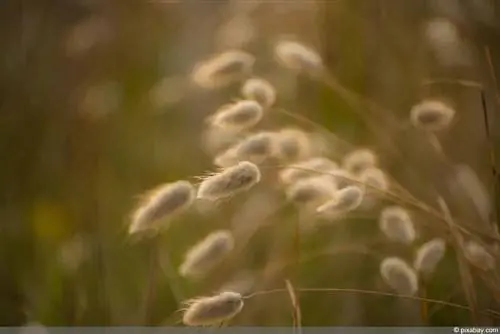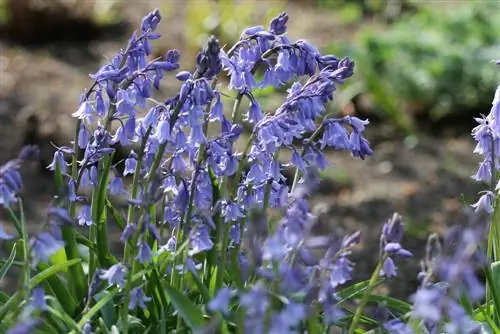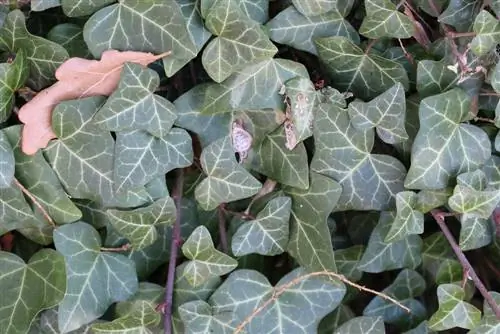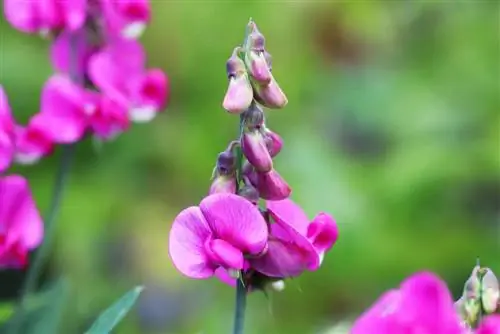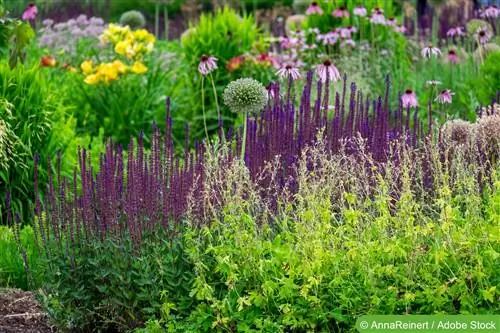- Author admin [email protected].
- Public 2023-12-17 03:39.
- Last modified 2025-01-24 12:45.
When little bushy bunny tails peek out from flowerbeds, it's adorable to look at. However, animal visitors are not responsible for this. There is actually a plant that produces these types of flowers in moderation: the sweet grass, aptly named haretail grass. Its shimmering silver flowers can also set unmistakable accents in your garden. Under optimal conditions it feels at home and blooms persistently.
Origin
The hare's tail grass is native to North Africa, as well as the Canary Islands and the Mediterranean region. Plenty of fine coastal sand and soil that is dry almost all year round await him there.
It started traveling centuries ago. Today, its velvety flowers can be admired on several continents, including here. The winters in this country are not comparable to the climate of his region of origin, but our summer weather suits him well.
Appearance and growth
The typical appearance of this plant always appears when its requirements are met and the care is correct. If something is not according to her modest wishes, she visibly weakens.
- grows upright towards the sky
- reaches a height of 30 to 50 cm
- Leaves are lanceolate and slightly hairy
- form a dense nest
- the leaf color is gray-green
Flowers and flowering time
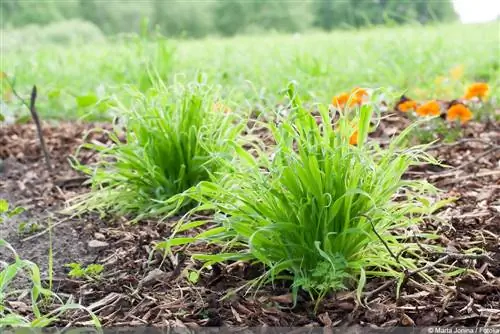
The inflorescence looks like a tiny rabbit tail. The first flowers appear from June and more and more follow. Under good conditions, their flowering period can extend into August.
- oval, 7 cm long inflorescence
- Flowers are initially colored green-violet
- later change to a creamy white tone
- sit on thin stems
- sticking out of the clump of leaves
Is haretail grass perennial?
This question must be answered clearly with a no. The ornamental grass does not survive the cold season, no matter how well-intentioned protective measures help. But the fact that it lacks winter hardiness isn't a big deal. The velvet grass comes back to life every year thanks to its seeds scattered everywhere. As soon as temperatures around 15 degrees Celsius prevail in spring, new plants can be seen near the old location.
- annual ornamental grass
- tolerates temperatures down to minus 6 degrees Celsius
- sows itself
- his existence continues seamlessly in the new season
Application options
The use of this ornamental grass in garden design or balcony greening is possible in a variety of ways:
- as a solitary plant or with several specimens of its kind
- also in appropriate company with other plants
- good in combination with colorful blooming flowers
- in open ground or pots
- as a low-growing path border
- as an eye-catcher and loosening up in rock gardens
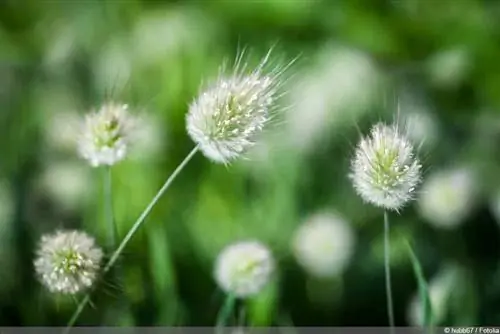
The more plants you group close together, the bushier and more striking the appearance will be. Then everything looks as if it were a single, strong and he althy growing plant.
Tip:
Cut off some almost ripe stalks in dry weather and let them dry upside down. They are an ideal component of dry bouquets.
Location
Lagurus ovatus, which is the botanical name of this plant, would always seek out a sunny location. There the hare's tail grass also finds the warmth that its cuddly soft flowers need. Spare him shade and yourself the stunted growth you can only expect from him.
Floor
This type of ornamental grass thrives in soil that is well enriched with nutrients and should also have a sandy content. A sandy soil is particularly important because the hare's tail grass does not tolerate moisture at all. The moisture that the unpredictable weather can sometimes cause must be able to seep away easily. The absence of lime is its second necessity. The less of this element in the soil, the better. Dry grass and roadsides, for example, are suitable places.
Plants
The grass plant is rarely available commercially as a finished plant in a pot. What is on offer in abundance, however, are its seeds. Every now and then it may happen that a plant that has already grown is available to you, for example as a gift from the neighboring garden. This should change the environment in spring while the season is still ahead of it.
Sowing
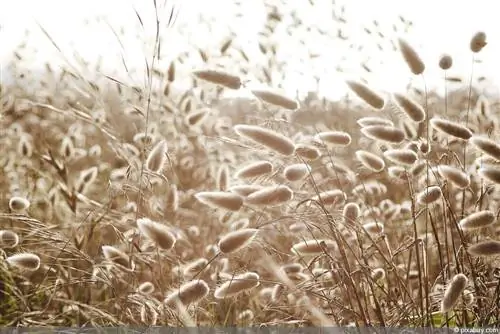
A bag of hare's tail grass seeds can be had in stores for just a few euros and is usually well filled. You should get it in good time in the spring so that sowing can start in March and not a possible day of life is wasted. However, it is also conceivable to wait until June. And this is how you turn dry seeds into lots of little rabbit tails:
- Place the seeds in water for about 8 hours. They swell and then germinate faster and better.
- Fill several small pots with soil. Above all, it should be well-drained. You are welcome to mix the soil with a little sand beforehand and loosen it up.
- Put several seeds in each pot, evenly spaced.
- Then cover the seeds with about half a centimeter of soil.
- Water the seeds well and keep the soil slightly moist afterwards.
- After about two weeks, the seeds germinate and the first plants become visible.
- Separate the plants by planting them in their own pots or in the garden. The distance between individual specimens should not be more than 10 cm, this will make the later growth look nice and bushy.
The seeds can definitely be sown directly into the garden soil. The challenge here lies in the required germination temperature of 15 degrees Celsius. There is no guarantee of this outdoors, especially when sown early in the year. However, since there are enough seeds in one package, if you don't succeed, you can try again a little later.
Tip:
The seeds of this type of ornamental grass are also ideal for gardening with small children. A seed grows into a complete plant within just one growing season. Just what impatient little gardeners want.
Propagate
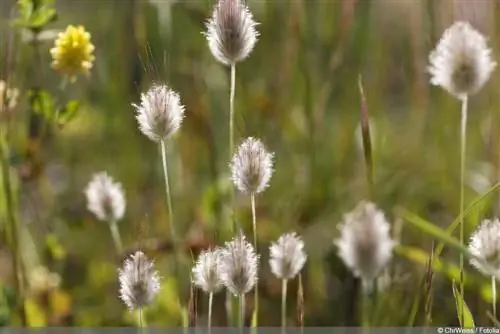
Hare's tail grass is propagated via seeds as previously described. These don't even have to be collected for subsequent years, as self-sowing works perfectly. In spring, just take a look at the old location to see whether a few new plants have appeared. If you want this in a new location, you can easily implement it. Of course, you can also tackle propagation in a targeted manner. It is then recommended to sow in several stages. Because the plants start at different times, they also start flowering at different times. So you have flowering ornamental grass specimens in your garden all summer long.
Fertilize
A good soil is enough for the hare's tail grass to live up to its name and grow plenty of velvety hare's tails. It can only be given some fertilizer occasionally, but only in very modest doses. An oversupply reduces the number of its flowers, which is definitely not what you want.
Pouring
The hare's tail grass is not bothered by dryness. Even if no rain falls from the sky for days, the gardener does not have to intervene. It can only be supplied with some water if it is dry for a long time, which is rarely the case in this country. The natural supply of water to the potted plants, however, is restricted by the walls surrounding their housing. The roots can only draw moisture from the potting soil. They can also tolerate drought, but still need watering more often than their outdoor counterparts. Your earth's environment simply dries out more quickly when it's hot. Slightly moist soil is ideal.
Cutting
The hare's tail grass grows as an annual plant. Any training and maintenance cuts are therefore not necessary. When its season is over with the first frost, the ornamental grass can be cut away or completely removed from the ground. However, it is much better to wait until spring. Dried inflorescences are an impressive sight in the garden even in winter.
Diseases and pests
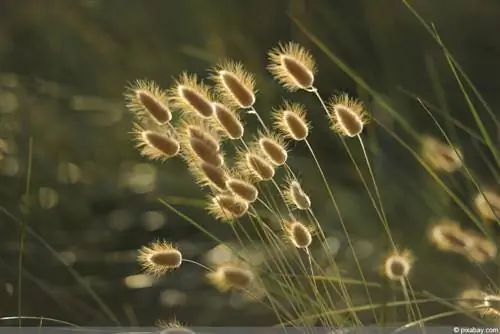
If the watering can stays away or keeps its visits to a minimum, the hare's tail grass will stay he althy from spring to fall. It is the constant wetness that robs it of its vitality and causes its roots to rot. Hare's tail grass that is weakened in this way is then more susceptible to further diseases and pests.
Wintering
The velvet grass, as the hare's tail grass is also often called, is an annual plant that does not need to be overwintered.
- annual ornamental grass
- can withstand temperatures down to minus 6 degrees Celsius
- dies in winter
- the dry plant parts are decorative
- can therefore be left standing until spring
Note:
It's not a big deal that the ornamental grass dies in winter. Since it likes to sow itself, new plants will definitely grow in the spring.

